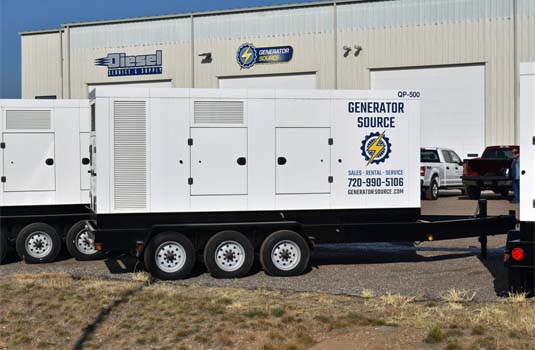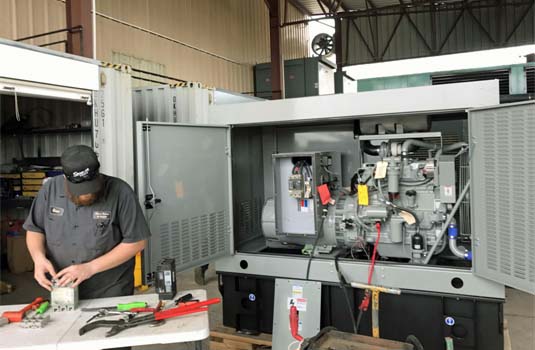|
 A primary concern when deciding what type of generator is best for your environment should be making certain you get the right electrical configuration. An electrical configuration typically includes the phase, voltage, kW, and hertz that are best for your application. In order to explain how phases and voltage work, it is helpful to understand what a generator set includes. A generator set (also known as a genset) is comprised of two primary components - an industrial engine (usually diesel, natural gas or propane) and a generator end. The engine produces horsepower and RPM, and the end coverts it into electricity. A primary concern when deciding what type of generator is best for your environment should be making certain you get the right electrical configuration. An electrical configuration typically includes the phase, voltage, kW, and hertz that are best for your application. In order to explain how phases and voltage work, it is helpful to understand what a generator set includes. A generator set (also known as a genset) is comprised of two primary components - an industrial engine (usually diesel, natural gas or propane) and a generator end. The engine produces horsepower and RPM, and the end coverts it into electricity.
Explaining Phases
Single-Phase Generators – for smaller single-phase loads, these gensets usually do not go above 40 kW. They are commonly used in residential environments and have a power factor of 1.0.
3-Phase Generators – mainly for larger industrial power generation, these gensets can provide both single and 3-phase power for running industrial motors with higher horsepower, branch power out for separate lines, and are in general more flexible. They are typically used in commercial environments and have a power factor of 0.8.
Increase Power Output Rating - you can convert single-phase to 3-phase power and sometimes gain approximately 20-30% kW output power rating, but the end needs to be re-connectable and you also need to account for load balances and a few other variables.
De-Rating (converting from 3-phase to single-phase) - typically reduces your kW output rating around 30%. For example, a 100 kW 3-phase generator would drop to around 70 kW when converted to single-phase.
• To accurately calculate the adjusted power you will end up with after de-rating, you should always try and de-rate from the kVA rating, instead of the kW rating. The formula is 2/3 kVA (for example, a 150 kVA single phase would de-rate to 100 kVA) then convert to kilowatts from there, if necessary.
• To de-rate the genset, the generator end in question must usually have 12 or 10 leads that can be reconnected. The load on the engine itself is not affected because it is the generator end essentially kicking into overdrive. If the generator is not re-connectable (or only connectable for high/low voltage), you can still apply single phase loads to it as long as you do not go over the rated amps on an individual line.
• The genset is limited by its electrical capacity based on the generator end and really does not have much to do with the engine.
Common Voltages on Commercial Generator Sets
Single-Phase
• 120
• 240
• 120/240
3-Phase
• 208
• 120/208
• 240
• 480 (the most common voltage for industrial gensets)
• 277/480
• 600 (mainly for areas in Canada)
• 4160 Volt
Voltage requirements can vary greatly for different types of equipment (for example other voltage options include; 220, 440, 2,400, 3,300, 6,900, 11,500, and 13,500)
 How to determine Your Required Voltage How to determine Your Required Voltage
To ensure the voltage configuration is exactly what you need, you should always consult an electrician or electrical contractor. They can evaluate your environment and determine the various loads your facility or operation will need, and will also be able to take into consideration other variables such as the voltage going into the building, maximum amperage, electric motor horsepower output and more. You can also reference our Power Calculator to run numbers. Use these numbers as a starting point and use an Amperage Chart , which is available here and other various manufacturer sites online. Make sure to consider the following key items listed below to help you determine the correct voltage for your generator setup:
• Required Voltage going into your facility or the power in from the mains transformer that is supplied in the building.
• Maximum amperage you require to run your specific equipment. If you do not know this information, the alternator amperes (for 3-phase alternators) can usually be cross-referenced with a chart to determine the size circuit breaker your generator will need.
• Startup amperage for industrial motors should also be taken into consideration. Many motors will run at a certain kW but have a much higher starting kW requirement. For example, you may need 200 kW and increased amperage at startup even though your average running load is only 90 kW. Electric motor horsepower requirements are also good to evaluate. Certain motors come with a soft starter that helps control the acceleration by applying voltage. Some industrial motors will provide all this information on their data tag.
• Utility Frequency also plays a role - the majority of the U.S. and parts of Asia are 60 Hz while the rest of the world is primarily 50 Hz. Most large ships and airplanes use a specialized 400 Hz frequency. To change the utility line power to a different frequency, a frequency converter can sometimes be used but there are additional factors to consider. Most generators can convert but some gensets will not function properly or may require additional parts and customization work. Consult your generator manufacturer for additional details on this type of situation.
Adjusting the Voltage of a Generator
Adjusting the voltage of generators is something that our expert technicians complete every few days in order to meet all the various combinations and specific electrical requirements of our customers. While the voltage can be adjusted on most generators, your specific options will always be limited based on the generator end you are working with.
The process of changing the voltage itself is a relatively technical electrical procedure that primarily involves adjusting the leads on the generator end. On most 3-phase gensets, we typically take the 10 or 12 leads in the generator end and reconfigure how those are arranged and connected, adjust their route to the control panel and a few other places - depending on what we are trying to accomplish. We insulate the wires well, adjust the sensing wires if req  uired, and then make additional changes from there if necessary. This is where terms like dogleg and double delta (or zig zag), Y-configuration and other various wiring schemes often get referenced. For more details on these terms, see our article on Phase Conversions . On 3-phase gensets we can change a 208V to 480V for example, or 480V to 240V, or almost any number of other combinations and phases using all the voltages that are currently available (as long as the generator end is re-connectable). uired, and then make additional changes from there if necessary. This is where terms like dogleg and double delta (or zig zag), Y-configuration and other various wiring schemes often get referenced. For more details on these terms, see our article on Phase Conversions . On 3-phase gensets we can change a 208V to 480V for example, or 480V to 240V, or almost any number of other combinations and phases using all the voltages that are currently available (as long as the generator end is re-connectable).
The generator end is the primary component that will determine how a generator will react when you alter the phase and/or voltage. When completed properly, altering the voltage should not harm or strain the unit in any capacity. Many customers require the availability of two or more system voltages from their standby generator set. This can include electric motors running at 480 Volt, appliances and production equipment using 208 Volt, and smaller loads and power tools at 240 Volt. You can achieve this with a 3-phase generator either by using a changeover switch or getting a dual voltage generator that is already made for that purpose. However, keep in mind that you are not able to simultaneously output multiple voltages from a single generator, you would need to manually switch the output to each different voltage or use a transformer to accomplish this.
There are a few limitations to be aware of when considering a voltage change. Specialized or high voltage gensets (4160 or 13,500 Volt for example) are not very practical for altering. You can change 600V to 480V but not the other way around. Also, on many 3-phase generators certain elements can sometimes be tough to access and work around. For example, they might have flexible conduit that wraps, panel doors that are in odd places, or enclosures that won’t allow our technicians easy access. While there is almost always a way to access the barrel and wiring on 3-phase generator ends, it can sometimes be difficult. One thing to also keep in mind is that some generator ends are not re-connectable so the wiring options and schemes available on those types of generators are very limited.
Another common thing we do when altering voltage is update components and review other potential equipment considerations in your system, including the following:
• Replace Gauges – whenever we alter the voltage on an older generator we often have to replace a number of gauges so that we can read the new output levels. One nice advantage the newer digital control panel offers is they can usually be reprogrammed.
• Breakers – we routinely change out the circuit breaker(s) on units to accommodate the amperage requirements of our customers. The breaker is usually attached to the generator end and it is a critical component that will help protect the generator by ensuring you do not exceed the rated amperage for that unit. Depending on if a customer wants everything all on one breaker or split out for any specific reason, we may change the configuration to something else (one 1200 Amp breaker or two 600 Amp ones, for example).
• Voltage Regulator – on most gensets when you reconnect the leads to a different voltage you must also carefully adjust the sensing wires that run to the regulator and/or control panel. If this is not done properly you can end up burning out the board or causing other damage. Most modern commercial generators have the voltage regulator integrated into the control panel now so you can adjust voltage settings from there and it helps do all the regulating. This is primarily a good advancement but does make board replacement much more costly due to the added functionality. Older gensets often have a separate piece of equipment attached that does the same types of things. All of these regulators work to automatically maintain a consistent voltage to make sure your equipment produces a consistent output.
• Transformer – if there is one present in your system, some of the wiring may also have to be reconfigured to accommodate the new voltage.
• Automatic Transfer Switch (ATS) – determining the amperage for this type of switch is also important because an ATS is a key part of ensuring you can automatically have the genset take over during a utility outage and also shut down once the power comes back on.
To summarize, there are many options available when it comes to phase and voltage combinations, configurations, and conversions. This can be an involved process so it is best to enlist professional help from a commercial electrician or experienced generator technician. However, if you have any questions on the issues covered in this article, would like help in sizing a genset, or if you would like assistance in determining what would be best for your specific environment, just call 800-853-2073 or Contact Us online.
|